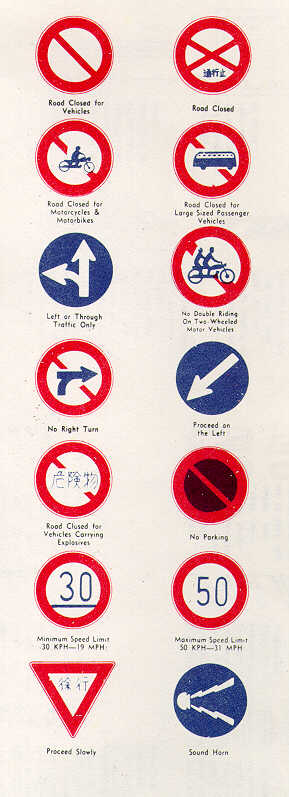Set 1
New International and Japanese Road Signs Used in Japan

Text taken from "Traffic Signs of Japan" (5 AFP 127-1), reprinted
20 Dec 91, by the Department of the Air Force.

- ROAD CLOSED FOR VEHICLES: This sign prohibits all vehicles from entering
the street protected by the sign.
- ROAD CLOSED: This sign prohibits the movement of pedestrians, bicycles,
carts, and motor vehicles of any type into the street protected by the sign.
- ROAD CLOSED FOR MOTORCYCLES AND MOTORBIKES: This sign prohibits the
movement of motorbikes, scooters, and motorcycles past this sign. Ordinary
bicycles, 3 wheeled motor vehicles, and all other 4-wheeled motor vehicles
may proceed past the sign without violation.
- ROAD CLOSED FOR LARGE-SIZE PASSENGER VEHICLES: This sign prohibits the
movement of large buses (capacity of 30 or more) past the sign.
- LEFT OR THROUGH TRAFFIC ONLY: No travel except in designated direction.
Self-explanatory; the main thing to remember is you can only go in the
direction the arrow is pointing.
- NO DOUBLE RIDING ON TWO WHEELED MOTOR VEHICLES: This sign is not
listed in the AFP, but should be self-explanatory!
- NO RIGHT TURN: This sign indicates no vehicle can cross the roadway to
right. This sign prohibits movement in the direction the arrow is
pointing.
- PROCEED ON THE LEFT: Proceed in designated direction. This sign is
posted in front of road obstructions to indicate direction of travel for all
vehicles (in this case, on the left).
- ROAD CLOSED FOR VEHICLES CARRYING EXPLOSIVES: This sign prohibits the
movement of dangerous cargo (explosive, flammable liquids, gunpowder, liquid
oxygen, etc.), beyond a specified limit. The sign will not normally apply
to off-duty activities but could be important if you are assigned the job of
driving a government vehicle. The sign must be identified by color and shape
and the Japanese symbols.
- NO PARKING: Parking is prohibited where this sign is erected. A broken
yellow line on the curb may designate the no parking zone.
- MINIMUM SPEED LIMIT 30 KPH - (19 MPH): Minimum speeds generally are
required on super highways and heavily traveled streets. These minimum
speeds are designated by round signs and indicate no motor vehicle can travel
at a speed less than that designated on the sign. It is important to
remember the only difference between minimun speed signs and maximum speed
signs is the heavy line below the minimum speed figure. REMEMBER- No line
beneath the figure means the maximum speed limit. Line beneath the figure
means the minimum speed limit.
- MAXIMUM SPEED LIMIT 50 KPH -(31 MPH): This sign indicates the maximum
speed a vehicle may travel under ideal conditions. Speed limits are
occasionally shown on the pavement with yellow figures.
a) Speeds vary on different roads and highways; for example, on a 6-lane
highway (3 lanes each way) three different speeds may be legal. Where
multiple-lane highways are built, lane speeds will be indicated by yellow
figures installed on pavement.
b) Numbers on speed signs indicate kilometers per hour (KPH),
not miles per hour (MPH).
- PROCEED SLOWLY: This sign indicates an area where speed must be reduced.
Reduced speed means to travel at such a speed as to be able to stop
immediately.
- SOUND HORN: This sign requires all vehicles sound horn (as at a curve
or a tunnel)

On to Set 2
Back to Transportation Page
© 1999 donella@bigfoot.com



![]()

![]()